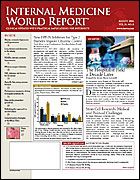Immediate Initiation of CPR Key to Surviving Cardiac Arrest
<20% of Patients Survive an In-Hospital Event
WASHINGTON, DC—Doctors caring for patients who are at risk for cardiac arrest should forget the basics of cardiac resuscitation they learned when they were residents. Instead, rapid initiation of cardiopulmonary resuscitation (CPR) is now considered the highest priority.
At this year’s annual meeting of the Society of Hospital Medicine, Jason Persoff, MD, of the Mayo Clinic, Jacksonville, Fla, reviewed the significance of the changes introduced in the revised advanced cardiovascular life support guidelines for cardiac arrest issued at the end of last year.
According to a large prospective study, about 375,000 to 750,000 cardiac arrests occur annually in the United States, and overall survival remains poor. Only 1 in 7 patients survive inpatient resuscitation.
The presenting rhythm is an important predictor of outcomes. Patients who present with ventricular fibrillation or ventricular tachycardia as their initial rhythm are most likely to survive cardiac arrest, but these are the least common initial rhythms in cardiac arrest. “The best thing to happen to your patients is for them to be in [ventricular fibrillation] or [ventricular tachycardia],” said Dr Persoff.
Although <20% of patients survive an in-hospital arrest, two thirds of those who are resuscitated are able to return home. Patients seem to think that being resuscitated implies living indefinitely on a ventilator.
Only 2% of patients who are resuscitated end up in a persistent vegetative state, but patients often ask not to be resuscitated for fear of a bad outcome. Thus, physicians need to do a better job explaining the benefits of resuscitation to their patients, according to Dr Persoff.
Physicians, too, are misinformed about the benefits of resuscitation. They tend to think that older patients are less likely to survive a resuscitation attempt than younger patients, but the research does not support this notion. “Age has no impact on whether you will survive a cardiac arrest,” Dr Persoff said. He added that although age is not an important predictor of survival, comorbid illness does predict survival.
“If somebody looks like he or she is in an arrest, start CPR while you are figuring it out,” Dr Persoff said. The new guidelines state that starting CPR within the first 5 minutes after ventricular fibrillation greatly increases the chances of the patient being shocked out of it.
Rapid use of a defibrillator is also essential. For every 60-second delay in defibrillation, survival decreases by 7%. Dr Persoff postulates that many clinicians do not use defibrillators aggressively enough during a cardiac arrest, because they fear harming a patient by shocking them. “Everyone is scared about harming the patient,” he said. But “by not shocking the patient, you are harming the patient.”
The new guidelines state that physicians should perform CPR before assessing the patient, and rescuers should be rotated to ensure that effective treatment is administered. “Doing CPR is incredibly labor intensive,” said Dr Persoff. CPR should continue until the code cart arrives, and the patient’s rhythm can be checked. One shock at the maximum setting should be given, and then CPR should be resumed. Clinicians no longer are asked to assess the pulse following the first shock to minimize wasted time.
Intubating a patient should not take precedence over restoring circulation. “Oxygenation cannot occur without circulation,” he said, adding that the data show that chest compressions are helpful in saving a life, but ventilation is not.
